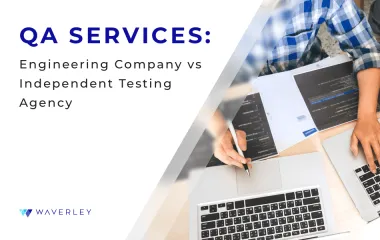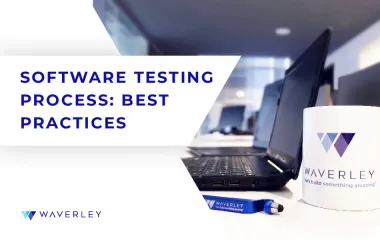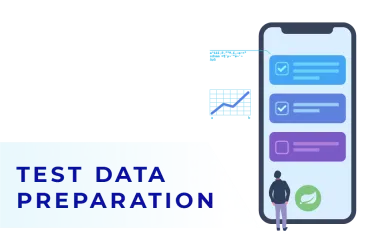How to Ensure the Quality of your Software Quality Assurance?

Contents
The main goal of a product or service is to bring value into the potential clients’ or users’ lives. Speaking of technology solutions, this goal is achieved when software products solve specific problems flawlessly, through an accessible and intuitive interface, and don’t cause new problems when operating. And this is thanks to people we call software quality assurance specialists, that we are now comfortably using so many high-quality products making our lives truly easier.
Quality Assurance and Quality Control make up an indispensable part of the software development life cycle we know today. We’ve been delivering software development projects for almost three decades, and none of them could be considered complete without meeting the quality requirements. In this article, we’d like to outline the must-haves of a successful QA process and share our secrets of high-quality software testing.
What Is Software Quality Assurance?
Every software application is unique in its own way. Some may have only a web or mobile interface, while others have both or are designed for desktop or other devices at all. Some require registration and login, some can gain access to sensitive data. Others need to be powerful enough to manage hundreds of thousands of users at the same time or to support sophisticated graphics. Assuring the quality of software, we test this unparalleled combination of functions, elements, protocols, and other interconnections in many ways.
Thus, building and testing software are creative activities. There are no out-of-box solutions or ready-made instructions with exact lines of code and testing scenarios that would simply lead to an expected result and ensure the quality of an app. Each development project takes careful learning and analysis of client requirements, customer satisfaction criteria, thorough system design, and workflow planning. In some cases, it requires adopting new technology stacks or tools, research for better alternatives, and even a long way of trial and error.
The task of Quality Assurance and Quality Control engineers is to make sure that each unique piece of software runs the way it was intended to, its characteristics correspond to the functional and quality requirements, and it’s user-friendly and powerful enough to fulfill the end goal. Sometimes, it calls for unusual approaches, experimenting, and guessing. However, the QA activities also include a number of tasks that are mandatory and standard for any software testing project and ensure the quality of this process. Let’s take a deeper look at the Quality Assurance process.
How Software Quality Assurance Works: the Complete Process
In the course of Agile software development, project development teams typically work on a defined set of tasks within two-week to month-long cycles called sprints. The goal of this methodology is to align each team member’s actions to the general plan, make relevant and continuous improvements to the development process, and support ongoing communication.
The QA team plays a key role in the entire process of Agile software development and tightly cooperates with the team of developers. This way, product team members can frequently communicate, exchange important feedback, ensure instant bug fixes in code, and guarantee high product quality of QA services. Here are the main steps of the Quality Assurance and Quality Control workflow.
Requirement Analysis
Before starting any action, it is important to take a bird’s-eye view of the entire project: its future end-users, needs to satisfy, and the value to deliver. With all this in mind, software testers analyze the basics – customer requirements. Even at this early stage, first-rate Quality Assurance specialists can locate errors and potential pain points. Also, product requirement analysis lays the foundation for a sensible testing scope definition.
Test Planning
Without planning, no software development process can reach success. Thus, upon analyzing and adjusting (if needed) the client’s requirements, QA engineers define the aspects of the software that must be tested. They create test cases – detailed descriptions of data inputs, execution conditions, testing procedures, and expected results. Test data preparation and the testing environment setup are other important elements of the planning stage.
Test Design
This phase for the QA team is the time to develop a testing strategy, create test scenarios and test cases, and organize the joint QA activities. During test design, the team sets up ways to effectively identify critical errors in software, provide the optimal amount of test coverage with minimal effort, and use the available resources efficiently.
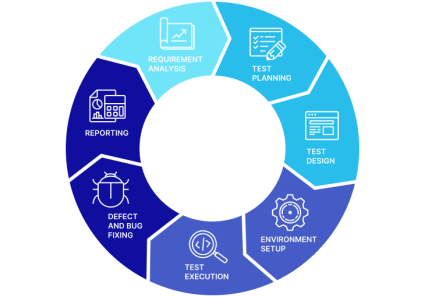
Test Execution
When the test plan and test cases/test scenarios are developed, Quality Assurance specialists can get down to practice. Here, based on the software development stage, they execute various types of tests.
There are many ways to test a software product. For example, one of the most widespread and straightforward test types is black-box testing. Here belong functional testing, UI/UX testing, and load testing used to check a system’s functionality, usability, stability, and performance, respectively.
When assuring the quality of software, QA engineers also develop white-box tests, designed to ensure the product’s security and the quality of code – unit tests and integration tests. Contrary to black-box testing, white-box tests require testing specialists well-versed in the system build and conception – in order to identify whether each part of the system (unit) works as intended separately and interacts with other parts (integration).
There’s also regression testing and acceptance testing. Regression tests help us ensure that the debugged or changed software element functions as it should. With acceptance testing, we check if the developed system meets the customer requirements set forth in the product specifications (yeah, we know them from the product and quality requirement analysis stage).
Defect and Bug Fixing
The effort needed for bug fixing or failure testing by a software engineer is inversely related to how well a bug or defect is reported and described by the Quality Assurance specialist. In order to describe and validate it in the best way possible, testers need to reproduce the bug (repeat it multiple times), understand and put down the specific flow of events causing it. This is the part of the QA activities when fine-tuned communication with the development team is particularly important.
Reporting and Documenting
Tracking and reporting are two more key elements of the software testing process. Various test tools help us boost the accuracy and speed of test management. These instruments take off the burden of excessive manual tasks and help avoid mistakes. To name a few, our Quality Assurance and Quality Control engineers use TestRail, Xray, Zephyr, and TestLink to manage the testing process, collaborate with fellow engineers, and let other project stakeholders track its progress.
Also, QA teams continuously create and follow testing documentation. Testing documentation may include test policy, test strategy, test plan, test scenario, test cases, defect reports, and test summary report, for example. All this makes the planning, execution, and review of the QA activities well-organized and verifiable. It also helps to provide more precise estimations for the required test effort and resources, test coverage, testing progress, and so on.
Recently, our Senior QA Engineers presented a more detailed overview of the software testing process.
Best Practices of Software Testing
Along with the IT industry becoming more mature, the software development community has worked out some operation principles, making this domain as efficient and productive as we know it now. We call these principles the best practices of software development and closely follow them in our daily work.
The Agile principles promote Continuous Delivery with its short development cycles, quick response to change, and focus on collaboration and communication with the customer and the team members. In the context of Quality Control and QA activities, this transforms into the start of the quality control process along with project initiation, quick feedback processing, and coding refined with instant bug fixes and continuous improvement.
Software Testing Principles
Over the decades of Agile software development history, each IT expertise has been forming their domain-specific rules and “laws” ensuring a unified approach to tackling tasks within their area of responsibility. The “seven commandments” for professional QA teams – the well-known Principles of Software Testing – proclaim a result-oriented approach, continuous improvement, and early testing start.
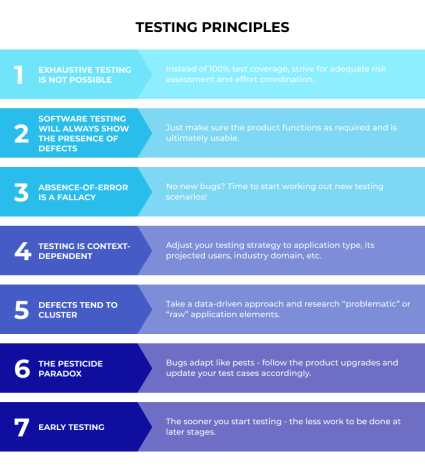
Practical Advice on Software Quality Assurance
Complimentary to the industry quality standards, at Waverley’s QA Lab we apply some practical rules based on our experience in software testing. With these case-hardened tips and tricks, we foster the best practices within the company and ensure the high quality of our Quality Assurance and Quality Cotrol services:
- No Friday releases. Sluggish as it may sound, haste makes definite waste in case of hurried releases and when critical bugs are found. There’s nothing worse than emergencies in production during the weekend, low customer satisfaction from day one, and stress for the product owner.
- Code freeze is a halt sign for every team member. Code freeze means that no changes can be made in code as it is expected to go live. Despite much criticism of this step in the context of the Agile software development process, it helps us make sure that no bugs will unexpectedly appear after the release.
- API testing for REST-ful API architecture. In contrast to UI and back-end testing only, API testing allows for early testing of applications, is language-independent and faster to automate, and helps to better ensure application security and product quality.
- Test automation, wherever possible. For instance, the automation of repetitive test cases saves time and costs, helps avoid man-made errors, and makes it possible for the QA teams to direct testing efforts towards more complex system elements.
- Gradual team scaling. We recommend our clients start off with a small QA team and grow it with time. With such an approach, it is easier to formulate realistic resource and expertise demands, tailor team composition, and find the necessary talents.
- Cross-team communication is key. The quality assurance process should be fully integrated with the development activities and validation process. Development and testing teams heavily rely on each other’s feedback in delivering a high-quality product.
Security in Quality Assurance
Along with profound application testing, reputable QA teams must guarantee the security of their customers’ software. We recommend implementing security measures at various security levels.
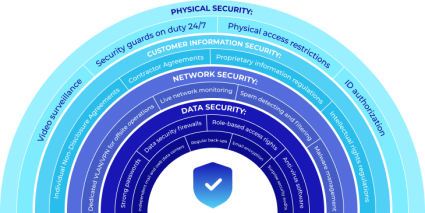
Software Quality Assurance Certifications
When you, as a business owner, look at a testing company, its Quality Assurance and Quality Control certifications will be the indicator of high-quality services and adherence to industry standards. This also means that a certified Quality Assurance specialist, apart from pure experience, has a vision based on both theoretical and practical knowledge. Thus, they can work independently and apply up-to-date quality assurance methods and testing approaches in their work, bringing true value to your project. Finally, available Quality Assurance certifications boost trust in the client-vendor relationships by providing confidence in the QA team’s expertise level.
So what Quality Assurance certifications can you find on the market, what level of expertise does it mean, and how do they differ?
For starters, proper Quality Assurance certifications can only be granted by authorized institutions, such as ISTQB (International Software Testing Qualifications Board), ISCB (International Software Certifications Board), ASQ (American Society for Quality), IIST (International Institute for Software Testing), for example. These bodies aim to foster high domain standards, continuous improvement of Quality Assurance and Quality Controlmethodology, and accessible learning.
The examples of Quality Assurance and Quality Control certifications include various levels of expertise, roles in the QA team, and qualifications:
- CAST (Certified Associate in Software Testing), CASQ (Certified Associate In Software Quality), CSTP (Certified Software Test Professional), and ISTQB Tester certifications are the foundation-level certifications, available for junior testing specialists with no or little experience in software testing and development. These certifications are good quality indicators for Junior to Middle QA Manual engineers, skilled in test planning, execution, and reporting, quality metrics and measurement, work process management, and team communication.
- CSTE (Certified Software Test Engineer), CSQA (Certified Software Quality Analyst), and ISTQB Advanced Level Test Analyst are practitioner-level certifications acquired by Quality Assurance professionals with a minimum of 4-6-year experience in the field and are proof of high-level competency and adopted best practices. These credentials certify the skills and competencies required for a Middle to Senior QA Manual engineer or a Junior to Middle QA Automation engineer: requirement analysis, test design, testing process management, test execution, test automation, and defect tracking.
- CMSQ (Certified Manager in Software Quality), CMST (Certified Manager in Software Testing), CTM (Certified Test Manager), and ISTQB Test Manager certifications are senior-level endorsements that testify the Quality Assurance specialist’s experience of over 8 years, managerial skills, and prior certifications in the field. With qualifications in test process management, test project management, test organization management, risk management, test automation strategies and architecture, and test process measurement and improvement, certified Test Managers can take the role of a QA Manager or a QA Team Lead.
Engagement Models in Software Testing
Software Quality Assurance and Quality Control services make up a substantial category of software development activities. Some companies specialize exclusively in manual and automated software testing, others are hardware testing pros, yet others may specialize in both software and hardware testing but for a specific industry, such as healthcare or finance, for example, boasting the domain-specific certifications that such products might require. Due to such a variety of Quality Assurance services, there have formed a range of collaboration models to choose from that can fit the multiple needs of product owners.
Quality Assurance Outsourcing
In this model, you get a dedicated QA team that organically makes up a part of your in-house or outsourced development team. Opt for the outsourcing engagement model if you need to outsource the burden of the talent hunt, providing people with facilities and equipment, and taking care of the onboarding process. At the same time, the outsourcing model allows you to take over project management and all the decision-making, if you wish to do so.
Quality Assurance Outstaffing
Quality Assurance outstaffing may feel like working with freelancers, but through a trusted and authorized resource. This engagement model is good for those willing to have the ultimate control over their QA teams, from hiring and face-to-face communication to tracking the work progress and time spent. Along with that, same as in the outsourcing model, the outstaffing model guarantees the quality of work, offers legally safe business partnerships, and grants you direct access to the global talent pool of remote QA engineers, allowing you to fill particular expertise gaps at the price you find acceptable.
The comprehensive comparative analysis of these two most popular engagement models from our QA Lead will give you some more insight. Meanwhile, there are two more out there!
QA-as-a-Service
This is like using Spotify but with software Quality Assurance: you pick the exact type of Quality Assurance or Quality Control service and use it for as long as you need. All you have to do is provide your service provider with the scope of work to be done and agree upon the payment for the service delivery. No endless interviews, lengthy meetings, or multiple approvals. The QA-as-a-Service engagement model is a good fit if you need to check the quality of the entire system or its part, cross-test your in-house development team’s work, or request a specific testing service, for example, automated testing, hardware testing, API testing, and so on.
Quality Assurance Consulting
If you need Quality Assurance Consulting services, you are most probably still in the development planning or initiation phase, or you need a second opinion about your current Quality Assurance process. Every piece of software is unique and requires a tailored testing approach and strategy. Thus, experienced QA specialists as consultants will help you prioritize your testing backlog, refine your testing plan, find process bottlenecks, and define the test tools to use best. The result of such work will be a set of recommendations to implement if you want to follow the best practices of Quality Assurance or improve your existing state of affairs.
Conclusion
- Quality Assurance and Quality Control isn’t as simple as it seems at first glance.
- Ensuring the quality of a product or service is a complex process consisting of multiple steps.
- There is a good deal of accessible tools, technologies, and test types that can be used. Test cases and scenarios that can be implemented are countless.
- The skills and qualifications of a Quality Assurance and Quality Control specialist can be learned and well-tested.
- There are clear-cut criteria for evaluating your software quality assurance process.
Waverley Software is an end-to-end software development company, which means our services cover every aspect of software development, including software Quality Assurance and Quality Control. Software testing is one of our core competencies, with a well-developed Manual and Automated Testing expertise for both hardware and software, top domain experts, an internal QA training program for newbies, and numerous running and complete Quality Assurance and Quality Control projects.

